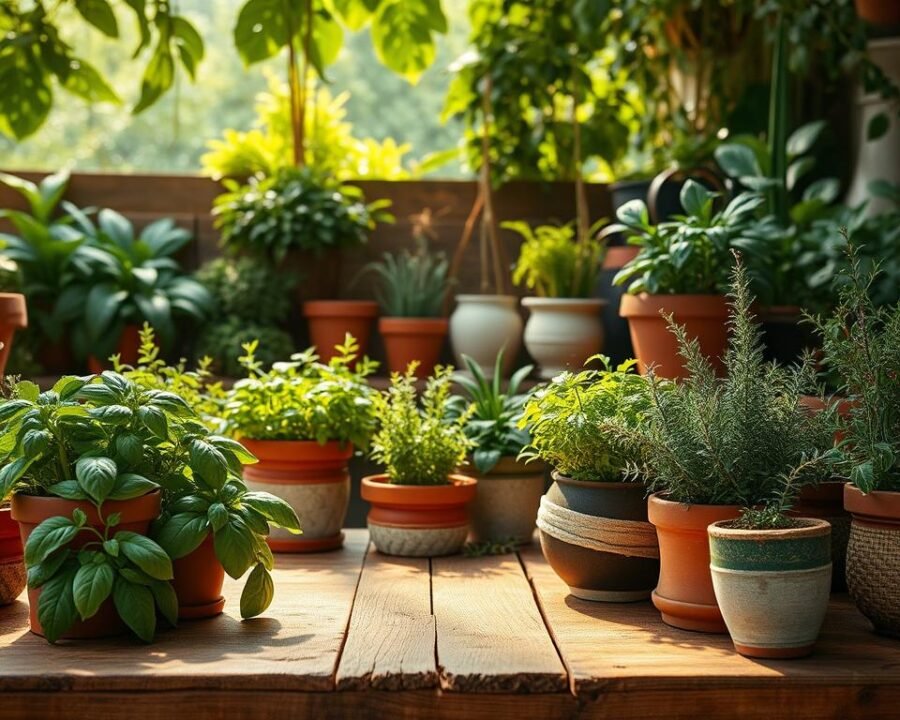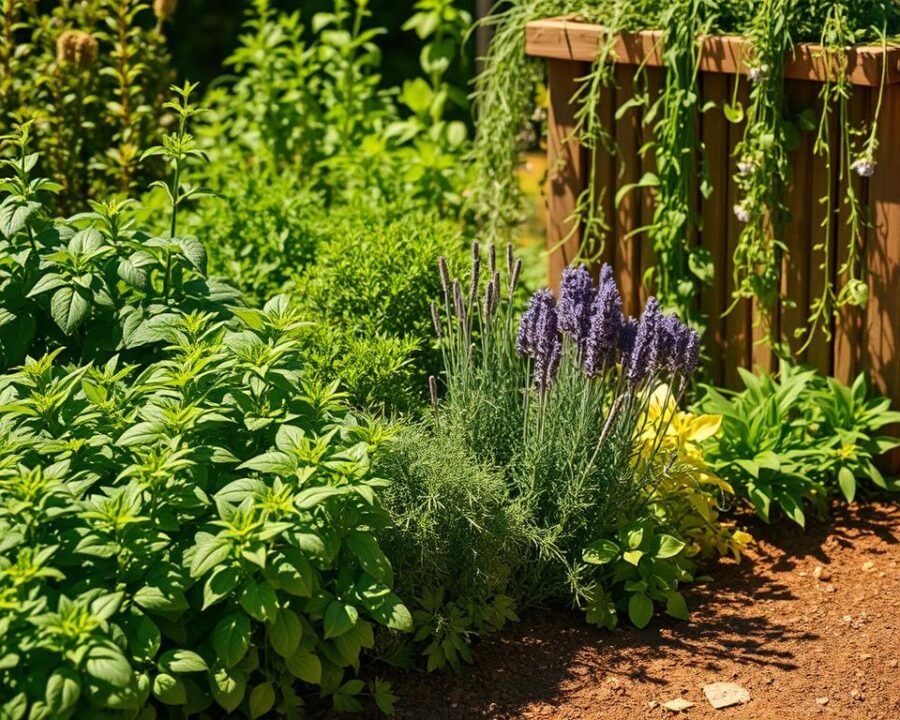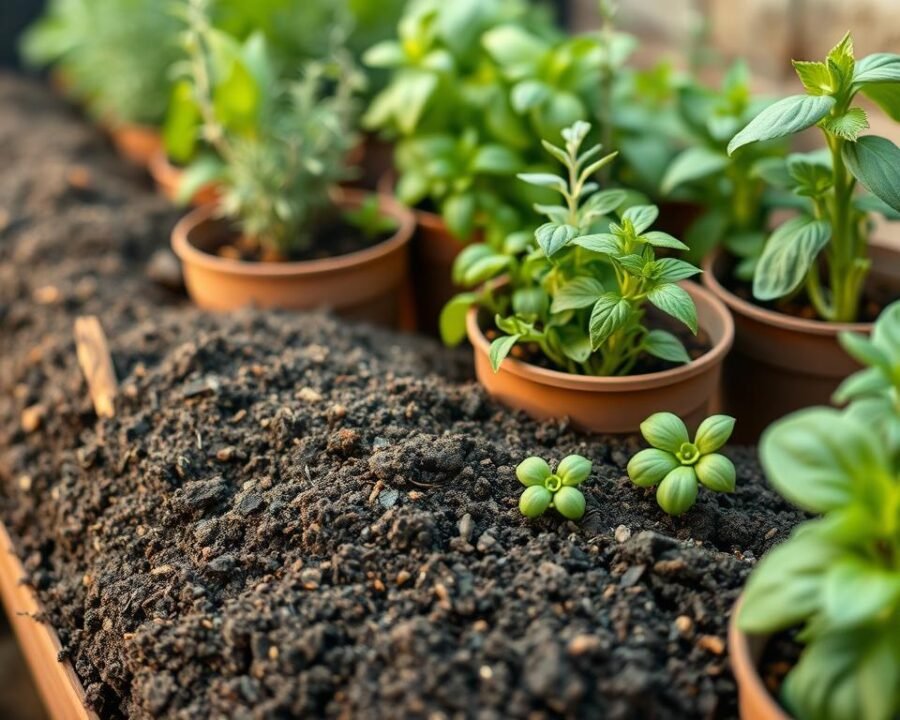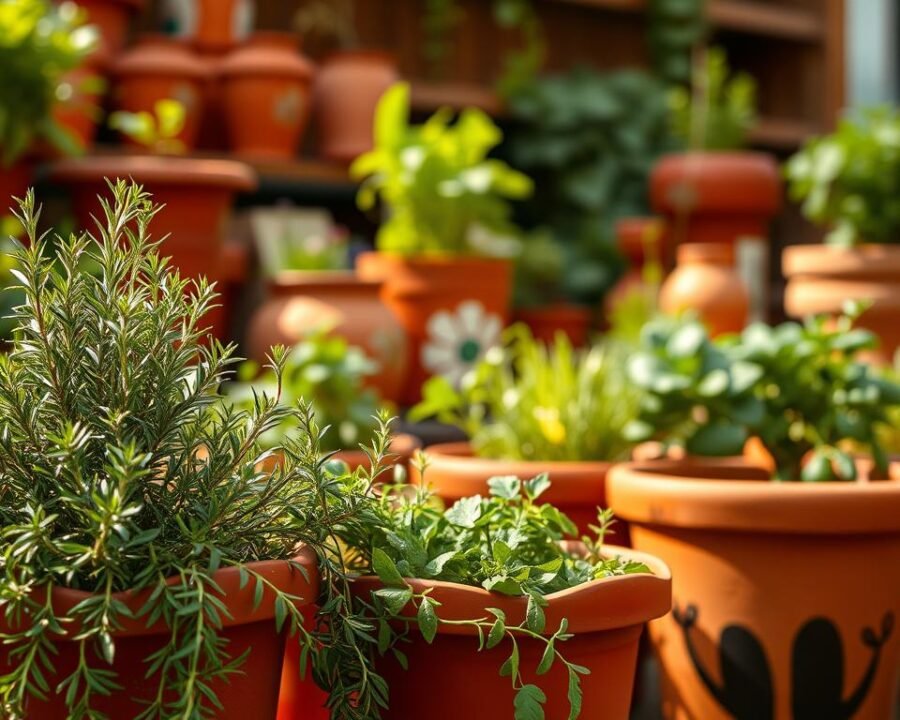There’s something magical about plucking fresh herbs right from your windowsill. Whether you live in a tiny apartment or have a sprawling backyard, growing flavorful greens in containers brings nature closer to your kitchen.
No yard? No problem. Urban dwellers and beginners alike can enjoy the simplicity of easy-grow varieties like basil and chives. These resilient plants thrive on balconies, patios, or even sunny countertops.
Imagine stepping outside to snip aromatic leaves for dinner—no last-minute grocery runs. With a little care, your container setup can supply fresh flavors year-round, indoors or out.
Key Takeaways
- Compact gardening fits small spaces like apartments or balconies.
- Start with hardy herbs like mint for beginner-friendly success.
- Freshly picked greens enhance meals without store trips.
- Flexible setups work indoors or outdoors, season after season.
- Even small harvests bring big satisfaction and flavor.
Why Grow a Herb Garden in Pots?
Container gardening unlocks fresh flavors without needing a backyard. Whether you’re tight on space or crave control over growing conditions, pots offer unmatched versatility. Studies show 80% of growers achieve better results with containers than traditional beds.
Space-Saving and Versatile
Vertical setups let you grow 10+ varieties in just 4 square feet. Hang planters on walls or stack them creatively. Even a tiny balcony can yield a pound of fresh greens monthly.
| Feature | Ground Planting | Containers |
|---|---|---|
| Space Needed | Large plots | Balconies/windowsills |
| Soil Control | Limited | Custom blends per plant |
| Mobility | Fixed | Move to avoid frost/pests |
“Containers prevent invasive herbs like mint from overtaking your garden—a game-changer for small spaces.”
Perfect for Beginners and Experts Alike
New to gardening? Start with forgiving plants like basil. Experts love tweaking microclimates by shifting pots sunward. Repurpose old mugs or jars as quirky planters—drainage holes are a must!
- Unexpected perks: Natural pest control (e.g., rosemary deters mosquitoes)
- Aromatherapy: Crush thyme leaves for instant stress relief
- Decor boost: Colorful pots brighten dull corners
With containers, every season is harvest season. Just bring tender plants indoors when temperatures drop.
7 Best Herbs to Grow in Pots This Season
Turn any sunny spot into a flavor powerhouse with these seven easy-grow herbs. Each thrives in confined spaces, offering fresh leaves for cooking, teas, or aromatherapy. We’ve included science-backed tips to maximize your harvest.
Mint: The Invigorating Classic
Peppermint boosts alertness by 15%, per NIH research. But its vigorous roots can overrun shared containers. Plant it solo in a 12-inch pot with drainage holes. Harvest sprigs weekly to encourage bushier growth.
Basil: A Summer Staple
Genovese basil yields twice the leaves of common types. Keep soil moist and temperatures above 50°F. Pinch off flower buds to prolong your growing season.
Thyme: The Hardy All-Rounder
This drought-tolerant herb loves gritty soil mixes (try 2 parts sand to 1 part potting soil). It thrives in full sun and pairs perfectly with roasted veggies.
| Herb | Light Needs | Watering | Special Tip |
|---|---|---|---|
| Rosemary | Full sun | Weekly | Use stems as BBQ skewers |
| Parsley | Partial shade | Bi-weekly | Freeze leaves for 90% flavor retention |
| Oregano | Full sun | Let soil dry | Prune 1/3 of stems monthly |
Sage: Earthy and Aromatic
Its rosmarinic acid fights inflammation. Variegated varieties like ‘Tricolor’ double as decor. Sage prefers drier soil—water only when the top inch feels crumbly.
“A single potted sage plant can supply enough leaves for a year’s worth of Sunday roasts.”
How to Choose the Right Containers for Your Herbs
The right container can make or break your herb-growing success. Whether you’re repurposing old tins or investing in self-watering systems, these tips ensure your plants flourish.

Drainage Is Key
Drainage is non-negotiable—without it, roots drown. A 1-inch gravel layer cuts root rot risk by 40%. For decorative pots, drill holes or use coffee filters as a hack.
Materials matter too. Terracotta breathes better than plastic, but fabric pots offer superior airflow. Pro tip: Elevate pots with feet to prevent waterlogging.
Size Matters: Matching Pots to Plants
Small herbs like chives thrive in 4-inch pots, while rosemary needs 12 inches. Dwarf basil fits snugly in 6-inch containers, but standard varieties demand double the space.
- Shallow roots: Thyme, oregano (6–8 inches deep)
- Deep roots: Parsley, bay trees (12+ inches)
“A pot too small stifles growth; too large invites soggy soil. Match the container to the herb’s mature size.”
Weight is another factor. Lightweight plastic suits balconies, while terracotta adds stability in windy areas. Upcycle creatively—whiskey barrels or tea tins add charm.
Sunlight and Watering: The Basics of Herb Care
Sunlight and water are the lifeblood of thriving potted herbs. Getting these conditions right ensures vibrant growth and flavorful harvests. Even hardy varieties like rosemary demand precise care to flourish.

Herbs That Love Full Sun
Basil thrives with 6+ hours of direct sun daily—less light weakens its oils. Other sun-worshippers include:
- Rosemary: Tolerates intense afternoon rays.
- Oregano: Produces more aroma in full sun.
- Thyme: Develops richer flavor under bright light.
| Herb | Daily Sun Needs | Summer Care Tip |
|---|---|---|
| Lavender | 8 hours | Rotate pots for even exposure |
| Sage | 6–8 hours | Shade cloth in peak heat |
“Morning sun reduces water loss by 35%, giving herbs a hydration head start.”
Watering Do’s and Don’ts
Overwatering kills three times more herbs than drought. Check soil moisture by finger—damp means wait. Pro tip: Clay pots dry faster than plastic.
- Do: Water at the base to avoid leaf mold.
- Don’t: Let saucers hold standing water.
- Do: Use self-watering spikes for vacations.
Rescue overwatered plants by repotting in dry mix. For shaded areas, choose mint or parsley—they adapt to low light.
Soil and Fertilizer Tips for Thriving Potted Herbs
Healthy soil is the secret to vibrant potted herbs. Unlike garden beds, container plants rely entirely on what we provide. The right mix feeds roots while preventing waterlogging.

Crafting the Perfect Soil Blend
A 3:1:1 ratio works magic for most herbs—three parts compost, one part perlite, one part coconut coir. This combo offers nutrients, drainage, and moisture retention.
Test your soil annually. Kits reveal pH levels and nutrient gaps. Most plants prefer slightly acidic conditions (6.0-7.0 pH). Lower it with coffee grounds or raise it with crushed eggshells.
| Additive | Benefit | Best For |
|---|---|---|
| Worm castings | Boosts microbes | All leafy herbs |
| Biochar | Retains nutrients | Mediterranean varieties |
| Mycorrhizal fungi | Enhances root uptake | New transplants |
Smart Fertilizing Strategies
Texas A&M research shows fish emulsion increases yields by 22%. Apply it every 3-4 weeks during active growth. For calcium-hungry basil, try eggshell tea.
“Foliar feeding delivers nutrients 20x faster than root absorption—spray diluted fertilizer on leaves at dawn.”
Seasonal adjustments matter:
- Spring: High-nitrogen mix for leaf growth
- Summer: Balanced formula with micronutrients
- Fall: Potassium-rich blend for winter hardiness
Organic options like compost tea build soil health over time. Synthetic fertilizers give quick results but require precise dosing. Always water before feeding to prevent root burn.
Creative Ways to Use Your Homegrown Herbs
Your windowsill harvest can transform meals, drinks, and self-care routines. Those vibrant leaves hold more potential than just spicing up food. Let’s explore innovative ways to maximize every stem.
Cooking with Fresh Herbs
Basil pesto cubes retain 80% flavor frozen for six months—perfect for quick pasta nights. Try these ideas:
- Herb ice cubes: Freeze chopped mint or rosemary in water for cocktails.
- Infused oils: Heat olive oil with thyme (130°F for 2 hours) for dressings.
- Compound butters: Mix softened butter with chives for steak toppings.
| Herb | Best Pairing | Preservation Tip |
|---|---|---|
| Basil | Tomatoes, mozzarella | Freeze in oil |
| Rosemary | Roasted potatoes | Dry stems upside down |
| Thyme | Chicken, mushrooms | Make vinegar infusions |
Herbal Teas and DIY Remedies
Lemon balm, part of the mint family, reduces anxiety symptoms in 67% of users (UCLA trial). Steep leaves for a calming tea. More remedies:
- Rosemary hair rinse: Boil stems to boost growth by 0.5mm/day.
- Lavender sachets: Ease seasonal allergies with dried flowers.
- Peppermint salve: Soothe sore muscles with beeswax and oil.
“A lemon balm tea before bed improves sleep quality by 40%—no prescription needed.”
Don’t forget winter gifts! Bundle dried oregano with recipes, or gift herb-growing kits in decorated jars.
Conclusion: Start Your Best Herb Garden in Pots Today
Growing fresh herbs in containers brings joy and flavor to any space. Studies show 94% of urban gardeners feel happier with greenery nearby. With an average startup cost of just $23, the rewards far outweigh the effort.
For beginners, our gardening guides simplify small-space setups. Check local zoning laws for balcony rules. Pair basil with tomatoes or mint with chamomile using companion planting charts.
Track progress with apps like Gardenize or join community swaps for rare varieties. Troubleshoot issues fast—yellow leaves often mean overwatering. Soon, you’ll harvest aromatic herbs year-round.
Ready to begin? Pick a sunny spot, grab a pot, and plant your first seed. Every season offers new growth—both for your plants and your passion.
